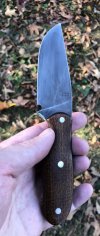ScarFoot
Knifemaker / Craftsman / Service Provider
- Joined
- Sep 16, 2021
- Messages
- 857
I’m making some small edc/hunting/skinning knives out of 1095 and they all came out of temper around 63 HRC. The knives have approx. 3” blades and I grind them down to a thickness between 0.10” - 0.075”. They also have clay hamons. I feel like they need to be closer to 60HRC for their intended purpose but am thinking about leaving one as is for personal use/testing.
What do y’all think? Should I temper them down a bit? I ran them at 405 degrees F to get them where they are now. The picture below is one I made out of W2 a while ago to give you an idea of overall size and blade shape.

What do y’all think? Should I temper them down a bit? I ran them at 405 degrees F to get them where they are now. The picture below is one I made out of W2 a while ago to give you an idea of overall size and blade shape.

